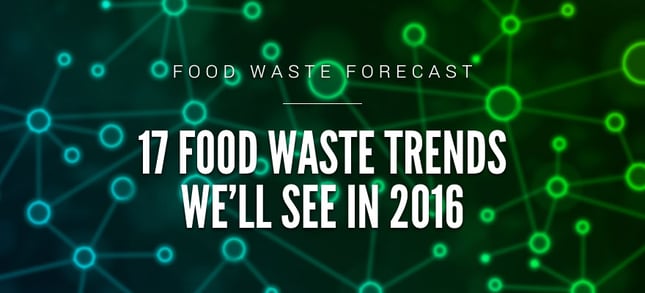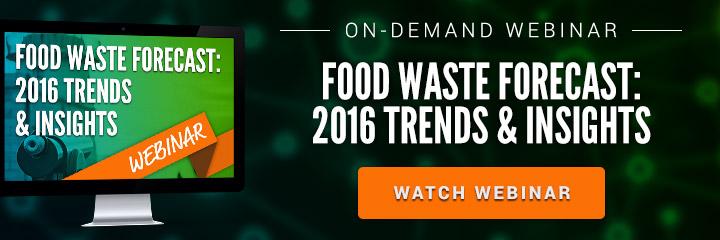Food Waste Intelligence
Subscribe to Food Waste Intelligence
Get our latest posts delivered right to your inbox.
Food Waste Forecast: 17 Food Waste Trends We’ll See in 2016

2015 was the biggest year yet for those of us working on solving the global issue of wasted food. It’s an exciting time to be working on this topic! But what’s ahead for 2016—will the momentum continue?
First, let’s take a look back at this historic year that’s now coming to a close.
- In January, we highlighted the 2015 National Restaurant Association Culinary Forecast. For the first time, food waste made it into the “What’s Hot” Top 10 trends. Proof that issue of wasted food was reaching the culinary community.
- Dan Barber opened Wasted, merging the worlds of wasted food and fine dining. This reframed the inherent potential in wasted food.
- Johns Hopkins Center for a Livable Future showed is that most people believe they do better than the average person when it comes to wasting food, highlighting that consumer perceptions don’t reflect reality.
- The mainstream media covered food waste in 2015 more than ever before. On HBO, John Oliver provided a succinct, funny, and moving segment that got right to the heart of the matter. (Highly recommended.)
- Doug Rauch, former President of Trader Joe’s, opened the Daily Table, a store delivering fresh and nutritious foods to those in need while combating food waste.
- Dana Gunders, staff scientist for the National Resources Defense Council, released the excellent Waste Free Kitchen Handbook, an at-home manual for people to waste less food.
- The USDA and EPA announced a first-ever U.S. food waste goal: reduce food waste by 50% by 2030.
- The UN adopted the Sustainable Development Goals, which include a goal to reduce food waste.
- In France, innovative regulation for donating excess foods was passed, stopped on a technicality, and is now on course again.
- In December, U.S. Congresswoman Chellie Pingree (D-ME) announced the Food Recovery Act, a comprehensive bill that seeks to address food waste from the farm to table.
Wow – what a year it’s been! So now, let’s look at what food waste trends we’ll see in 2016...
2015 was a deflationary food cost environment (with the exception of a few key items, like eggs). The concern is that there may be less pressure to reduce waste when prices are falling, but don’t hold your breath: the U.S. Bureau of Labor and Statistics projects a return to food cost increases in 2016.
People recognize that data is an essential tool in fighting food waste. There will be a thirst for ever-greater data—on quantification and characterization—in 2016. It’s also time sensitive: with all the good work happening on food waste, we need baselines very soon to allow us to measure progress. Many of us are fluent with the standard food waste statistics, but we need to make them stronger and ready to withstand hard questions from those who may wish to minimize the issue.
We need data that’s consistent and comparable. The World Resources Institute (WRI) Food Loss & Waste Protocol, a standard on global food loss and waste management, should be available in Q1 2016. This will allow us to compare data, share data, and create more accountability, all within a flexible framework. But, remember that a new standard for something as complex as food loss and waste measurement won’t be deployable without some effort. It will require persistence; we need to make sure we all commit to using these standards.
I love the aspirational concept underlying zero food waste, both the idea of eliminating waste and closing loops throughout the production-consumption-recovery chain. However, I remain concerned that the term “zero waste” has become a marketing concept that doesn’t deliver on its promise (see my article on this topic in BioCycle Magazine). We need to focus on both prevention and diversion when we talk about “Zero Waste,” and we shouldn’t declare success when we reach a 90% diversion rate. Rather, we need to report on reduction in generation and then on increases to diversion. If we claim zero, we need to mean zero. Let’s not declare a touchdown at the 10-yard line.
The terrific U.S. EPA Food Recovery Hierarchy might encounter competition in 2016, or at least pressure to evolve. Specifically, there’s tension between the industrial uses and composting tiers, where both are valid approaches. The ReFED initiative will introduce a different framework entirely when its report is released in Q1 detailing food waste actions in the context of both impact and cost. They have drawn inspiration from the well-known McKinsey carbon abatement curve and applied similar methods to food waste.
The United States needs to cut food waste in half by 2030, but how? Public officials need feedback and engagement from all of us. We have a short timeline to establish a strategy before all the players change with a new administration. We also need to support Congresswoman Pingree’s bill.
In 2016, consumer education will take center stage. The Ad Council will release a campaign on food waste (think Smokey the Bear for food waste). Ad Council campaigns have historically been highly influential in changing perceptions and behaviors.
When we waste food, we waste water. With water so scarce in parts of the U.S. and globally, this is more apparent (and important) than ever. Access to water is one of the major issues of our time, and it will become a key part of the food waste discussion.
In 2016, we’ll see much more public action at the city, county and state levels. This will grow beyond the cities and regions that were first-movers, as more communities set goals and provide technical assistance programs. There will also be work to define which municipal models work best and replicate them.
Someone recently asked me how they could get into the “food waste industry.” At that moment I realized: “wow, we’re getting close to critical mass as an industry.” This includes NGOs, foundations investing in venture philanthropy, and an entrepreneurial segment. This community will be figuring out how best to work together in 2016, avoiding duplication and finding leverage.
In the foodservice world, there are some “sacred cows” that drive food waste and will be challenged in 2016. For example, in buffet environments, we’ll see more operations transition away from policies that “the last customer needs to have the same experience as the first” because they’re simply too wasteful. We can do better and even provide fresher food by merchandising less.
We should also challenge the adage, “when in doubt, throw it out.” In 2016, many will start to understand ways to get more value from food that might otherwise be discarded reflexively, and will do so without compromising safety. We’ll also continue to see more adoption of cosmetically imperfect produce, perhaps to the point where supply for some items could be crimped.
Years ago, it was composting that received all the attention. Now, there’s appropriate and growing focus on food recovery. Many non-profits and entrepreneurs are working on new ways to connect excess food with people who need it (Feeding Forward, Spoiler Alert, Flash Food, Peninsula Food Runners, and Zero Percent are a few of many examples).
We also expect more dialogue on whether prevention and recovery are food waste initiatives at odds. (I don’t think so–click here for a recent article on that topic.) There’s plenty of wasted food and plenty to prevent. But we need to be careful about messaging—prevention needs to be the #1 goal.
This is a critically important avenue to address food waste over the long term, and we expect ongoing focus on childhood food waste education. The International Food Waste Coalition is leading a new effort focused on changing food waste behavior in schools.
In the past few years, we’ve seen a lot of regulation passed involving landfill restrictions on organic waste disposal. But most “bans” include caveats related to size of generator or available food waste recycling infrastructure. We expect more infrastructure to come online in 2016, which means it will be time for more to participate. That said, we don’t expect heavy focus on enforcement in 2016.
Packaging can substantially extend the longevity of certain food. Expect to see more empirical research in 2016 on the linkages and tradeoffs between packaging and food waste minimization.
We expect culinarians and entrepreneurs to aggressively develop items that were previously considered “waste” and turn them into viable food products. In 2015, we saw things like Coffee Flour, as well as a variety of dried fruit, jam and veggie snacks emerge. We await the tasty inventions of 2016!
From 2005 to 2015, the number of Google searches on “food waste” increased steadily. People are paying attention to this issue. However, there will always be other topics competing for attention. For example, in the recently released 2016 National Restaurant Association ”What’s Hot” Culinary Forecast, food waste slipped from number 9 to 19 on the list of chef’s priorities. We need to work hard to keep food waste management top of mind!
A few more things I would love to see in 2016:
- We need a U.S. version of WRAP, UK’s Waste and Resource Action Programme. This would be an independent organization that intersects all areas of food waste.
- We need waste-aware public purchasing standards to be included in contracts issued at the federal, state and local level. This would food waste reduction and mandatory measurement requirements in the many government foodservice operations such as hospitals, universities and military facilities.
- We need date label reform on packaged foods.
What Should the Foodservice Industry Do?
There are three things the foodservice industry, specifically, should do in 2016:
- Establish a voluntary group – similar to the Hospitality and Food Service Agreement launched by WRAP in the UK.
- Set an industry goal of 50% reduction of food waste, to mirror the national goal.
- Report on aggregate food waste transparently and more comprehensively.
2016 holds much promise for those working to reduce food waste, including both operators and advocates. I’m excited to see how things develop!
